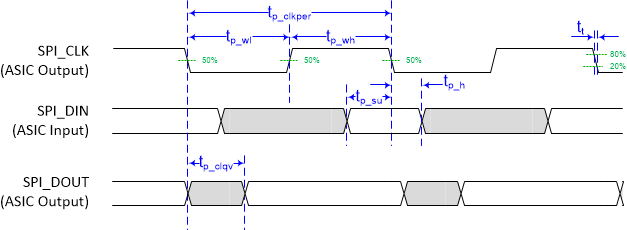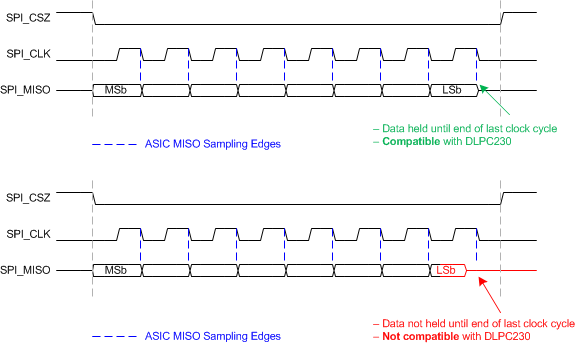DLPS201E August 2020 – August 2024 DLPC230S-Q1 , DLPC231S-Q1
PRODUCTION DATA
- 1
- 1 Features
- 2 Applications
- 3 Description
- 4 Pin Configuration and Functions
-
5 Specifications
- 5.1 Absolute Maximum Ratings
- 5.2 ESD Ratings
- 5.3 Recommended Operating Conditions
- 5.4 Thermal Information
- 5.5 Electrical Characteristics
- 5.6 Electrical Characteristics for Fixed Voltage I/O
- 5.7 DMD High-Speed SubLVDS Electrical Characteristics
- 5.8 DMD Low-Speed SubLVDS Electrical Characteristics
- 5.9 OpenLDI LVDS Electrical Characteristics
- 5.10 Power Dissipation Characterisics
- 5.11 System Oscillators Timing Requirements
- 5.12 Power Supply and Reset Timing Requirements
- 5.13 Parallel Interface General Timing Requirements
- 5.14 OpenLDI Interface General Timing Requirements
- 5.15 Parallel/OpenLDI Interface Frame Timing Requirements
- 5.16 Host/Diagnostic Port SPI Interface Timing Requirements
- 5.17 Host/Diagnostic Port I2C Interface Timing Requirements
- 5.18 Flash Interface Timing Requirements
- 5.19 TPS99000S-Q1 SPI Interface Timing Requirements
- 5.20 TPS99000S-Q1 AD3 Interface Timing Requirements
- 5.21 DLPC23xS-Q1 I2C Port Interface Timing Requirements
- 5.22 Chipset Component Usage Specification
- 6 Parameter Measurement Information
-
7 Detailed Description
- 7.1 Overview
- 7.2 Functional Block Diagram
- 7.3
Feature Description
- 7.3.1 Parallel Interface
- 7.3.2 OpenLDI Interface
- 7.3.3 DMD (SubLVDS) Interface
- 7.3.4 Serial Flash Interface
- 7.3.5 Serial Flash Programming
- 7.3.6 Host Command and Diagnostic Processor Interfaces
- 7.3.7 GPIO Supported Functionality
- 7.3.8 Built-In Self Test (BIST)
- 7.3.9 EEPROMs
- 7.3.10 Temperature Sensor
- 7.3.11 Debug Support
- 7.4 Device Functional Modes
-
8 Application and Implementation
- 8.1 Application Information
- 8.2 Typical Application
- 8.3 Power Supply Recommendations
- 8.4
Layout
- 8.4.1
Layout Guidelines
- 8.4.1.1 PCB Layout Guidelines for Internal ASIC PLL Power
- 8.4.1.2 DLPC23xS-Q1 Reference Clock
- 8.4.1.3 DMD Interface Layout Considerations
- 8.4.1.4 General PCB Recommendations
- 8.4.1.5 General Handling Guidelines for Unused CMOS-Type Pins
- 8.4.1.6 Maximum Pin-to-Pin, PCB Interconnects Etch Lengths
- 8.4.1.7 Number of Layer Changes
- 8.4.1.8 Stubs
- 8.4.1.9 Terminations
- 8.4.1.10 Routing Vias
- 8.4.2 Thermal Considerations
- 8.4.1
Layout Guidelines
- 9 Device and Documentation Support
- 10Revision History
- 11Mechanical, Packaging, and Orderable Information
5.19 TPS99000S-Q1 SPI Interface Timing Requirements
The DLPC23xS-Q1 ASIC to TPS99000S-Q1 interface consists of an SPI serial interface.
| (1) | MIN | MAX | UNIT | ||
|---|---|---|---|---|---|
| fclock | Clock frequency, PMIC_SPI_CLK | 9.998 | 30.006 | MHz | |
| tp_clkper | Clock period, PMIC_SPI_CLK (50% reference points) | 33.3 | 100 | ns | |
| tp_wh | Pulse duration high, PMIC_SPI_CLK (50% reference points) | 11.5 | ns | ||
| tp_wl | Pulse duration low, PMIC_SPI_CLK (50% reference points) | 11.5 | ns | ||
| tt | Transition time – all input signals | 20% to 80% reference points | 6 | ns | |
| tp_su | Setup time – PMIC_SPI_DIN valid before PMIC_SPI_CLK falling edge (50% reference points) | 7.0 | ns | ||
| tp_h | Hold time – PMIC_SPI_DIN valid after PMIC_SPI_CLK falling edge | 50% reference points | 0.0 | ns | |
| tp_clqv | PMIC_SPI_DOUT output delay (valid) time (with respect to falling edge of PMIC_SPI_CLK or falling edge of PMIC_SPI_CSZ0) | –3.0 | 3.0 | ns | |
(1) The DLPC23xS-Q1 communicates with the TPS99000S-Q1 using a slight variant of SPI Transfer Mode 0 (that is, clock polarity = 0, clock phase = 0). Instead of capturing MISO data on the clock edge opposite from that used to transmit MOSI data, the DLPC23xS-Q1 captures MISO data on the same clock edge used to transmit the next MOSI data. As such, the DLPC23xS-Q1 SPI interface to the TPS99000S-Q1 requires that MISO data from the TPS99000S-Q1 remain active until the end of the full clock cycle to allow the last data bit to be captured. This is shown in Figure 5-12.
 Figure 5-9 TPS99000S-Q1 Interface Timing
Figure 5-9 TPS99000S-Q1 Interface Timing Figure 5-10 TPS99000S-Q1 Interface Data Capture Requirements
Figure 5-10 TPS99000S-Q1 Interface Data Capture Requirements